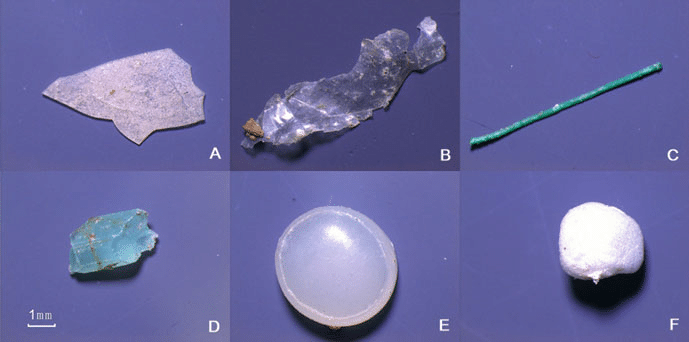Adapted from Arocha’s Guidelines for sampling microplastics on sandy beaches
A stretch of beach at least 100m in length is recommended. The site should be divided into 10m segments, which can be marked using sticks of bamboo. Within each segment, a square of 50cm by 50cm should be selected at random and also marked using Saté sticks and string. Random site selection can be done using a random number generator such as the one at https://www.random.org/ to give distances in meters to locate the site within each segment. A number between 1 and 10 should be selected for the location along the beach, and a number between 1 and ~50 for the distance from the ocean (depending on the width of the beach, it should be before vegetation starts).
Collection
Materials
- 2 buckets
- Water filter fabric (with 100-300 μm mesh)
- Elastics
- Measuring tape
- Saté bamboo grill sticks
- String
- Small metal shovel
- Metal sieve 5mm mesh
- Metal sieve 1mm mesh
- Metal Tweezers
- Magnifying glass
- Glass jar with a date & location
- Clipboard & form
- Cotton towel
Methods
- Filter sea water
- Cover the filter fabric over one bucket and hold it in place with an elastic
- Slowly pour ocean water into the bucket to filter out any micro plastics
- Once done cover the bucket
- Prepare the research area
- Locate and mark your sampling location with a bamboo stick
- Stand downwind from the sampling location
- Using the stick as the top right corner, measure and mark a 50cm by 50cm square with bamboo sticks and string
- Pour filtered water over the square to hold the sand in place
- Collect sample
- Use a small metal shovel to dig 5 cm deep
- Put the top 5cm of sand into a bucket
- Take out pebbles, shells, wood or seaweed and wash them with filtered seawater using the fine mesh strainer to catch any micro plastics
- Use a magnifying glass to double check for any remaining microplastics
- Put the large items back at the beach and any micro plastics into the glass collection jar
- Filter sample
- Place a 5mm mesh on top of a 1mm mesh
- Use a metal spoon to put sand in the 5mm mesh and wash the sand through with filtered seawater
- Whatever gets through the 1mm filter stays at the beach
- Put what is left in the 1mm filter into the glass collection jar
- Check the top 5mm filter for micro plastic
- Take them out with tweezers
- Put them in the glass collection jar
- Throw the rest of the sand back on the beach
Analysis
Materials
- For analysis:
- Glass dishes
- Black and white paper cards
- Light
- Magnifying glass
- Tweezers
- Teasing needles
- Saté sticks
- Microscope
- Ruler
- Glass storage jar
- Labels
- Marker / pencil
- Data sheet
- Camera
Methods
- Put the sand from the jar in a glass bowl with filtered sea water
- Stir the dish to release pieces from each other
- The microplastics should float
- Place black and white paper under the bowl to see different plastics
- Shine a light over the water to see transparent films
- Take out pieces with metal tweezers and place them in a petri dish
- Organic pieces may disintegrate when prodded
- Identify micro plastics under a microscope or magnifying glass
- Classify micro plastics according to the photo guide below
- If you see cell structures under a microscope it is organic and not plastic
- Take a picture of each piece and overall collection
- Record findings in form below

Shapes of typical microplastics collected from inland waters Qinghai Lake and Three Gorges Reservoir in China|Shapes of typical microplastics collected from inland waters (Qinghai Lake and Three Gorges Reservoir) in China (a, sheet; b, film; c, line/fiber; d, fragment; e, pellet/granule; f, foam)<ref>Microplastic Pollution in Inland Waters Focusing on Asia – Scientific Figure on ResearchGate. Available from: https://www.researchgate.net/figure/Shapes-of-typical-microplastics-collected-from-inland-waters-Qinghai-Lake-and-Three_fig1_321203508 [accessed 3 Sep, 2019]</ref>]]
| Category label | Type of plastic | Quantity found |
|---|---|---|
| A | sheet | |
| B | film | |
| C | filament/string | |
| D | rigid | |
| E | pellet | |
| F | foam |

